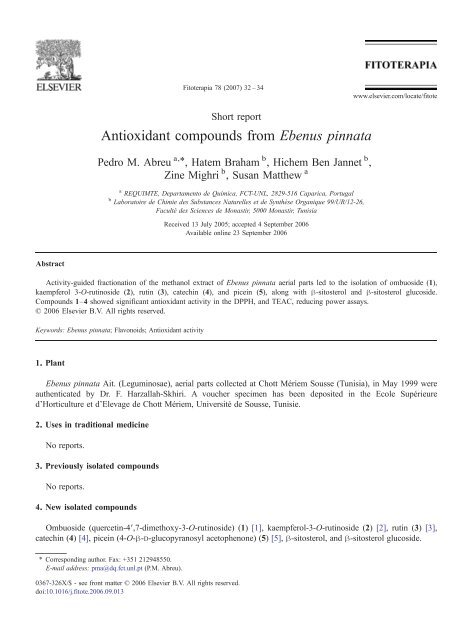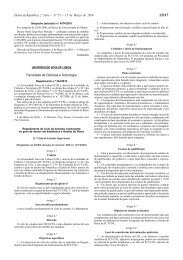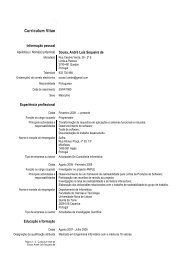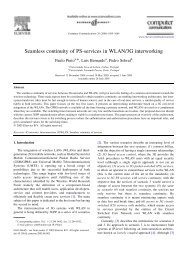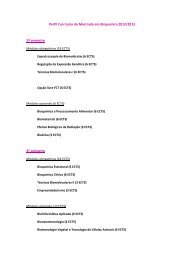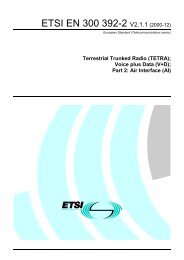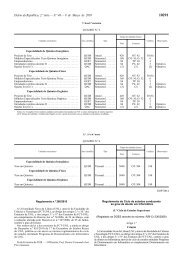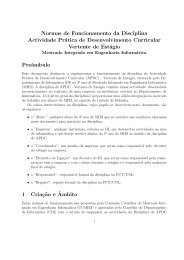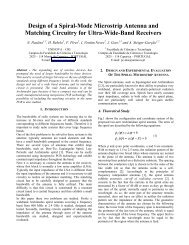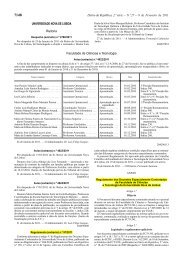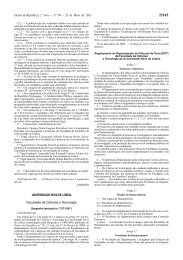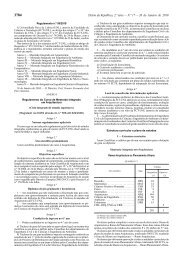Antioxidant compounds from Ebenus pinnata
Antioxidant compounds from Ebenus pinnata
Antioxidant compounds from Ebenus pinnata
Create successful ePaper yourself
Turn your PDF publications into a flip-book with our unique Google optimized e-Paper software.
Fitoterapia 78 (2007) 32–34www.elsevier.com/locate/fitoteShort report<strong>Antioxidant</strong> <strong>compounds</strong> <strong>from</strong> <strong>Ebenus</strong> <strong>pinnata</strong>Pedro M. Abreu a, ⁎ , Hatem Braham b , Hichem Ben Jannet b ,Zine Mighri b , Susan Matthew aa REQUIMTE, Departamento de Química, FCT-UNL, 2829-516 Caparica, Portugalb Laboratoire de Chimie des Substances Naturelles et de Synthèse Organique 99/UR/12-26,Faculté des Sciences de Monastir, 5000 Monastir, TunisiaReceived 13 July 2005; accepted 4 September 2006Available online 23 September 2006AbstractActivity-guided fractionation of the methanol extract of <strong>Ebenus</strong> <strong>pinnata</strong> aerial parts led to the isolation of ombuoside (1),kaempferol 3-O-rutinoside (2), rutin (3), catechin (4), and picein (5), along with β-sitosterol and β-sitosterol glucoside.Compounds 1–4 showed significant antioxidant activity in the DPPH, and TEAC, reducing power assays.© 2006 Elsevier B.V. All rights reserved.Keywords: <strong>Ebenus</strong> <strong>pinnata</strong>; Flavonoids; <strong>Antioxidant</strong> activity1. Plant<strong>Ebenus</strong> <strong>pinnata</strong> Ait. (Leguminosae), aerial parts collected at Chott Mériem Sousse (Tunisia), in May 1999 wereauthenticated by Dr. F. Harzallah-Skhiri. A voucher specimen has been deposited in the Ecole Supérieured'Horticulture et d'Elevage de Chott Mériem, Université de Sousse, Tunisie.2. Uses in traditional medicineNo reports.3. Previously isolated <strong>compounds</strong>No reports.4. New isolated <strong>compounds</strong>Ombuoside (quercetin-4′,7-dimethoxy-3-O-rutinoside) (1) [1], kaempferol-3-O-rutinoside (2) [2], rutin (3) [3],catechin (4) [4], picein (4-O-β-D-glucopyranosyl acetophenone) (5) [5], β-sitosterol, and β-sitosterol glucoside.⁎ Corresponding author. Fax: +351 212948550.E-mail address: pma@dq.fct.unl.pt (P.M. Abreu).0367-326X/$ - see front matter © 2006 Elsevier B.V. All rights reserved.doi:10.1016/j.fitote.2006.09.013
P.M. Abreu et al. / Fitoterapia 78 (2007) 32–34335. Studied activity<strong>Antioxidant</strong> activity evaluated using three different assays [6]: DPPH (2,2-diphenylpicryl hydrazyl) scavengingactivity [7], ABTS U+ scavenging activity according to the modified TEAC method of Re et al. [8], and reducing powerassay according to the method of Oyaizu [9].6. Tested materialMethanol extract of E. <strong>pinnata</strong> aerial parts, CHCl 3 and EtOAc fractions obtained <strong>from</strong> partition with a suspension ofthe MeOH extract in water, and <strong>compounds</strong> 1–4.7. ResultsReported in Table 1.8. ConclusionsThese results are in agreement with reported structure–activity relationships for flavonoid antioxidants, whosescavenging effects depend on the hydroxylation pattern of rings A, B, and C, O-methylation, the presence of a 2,3double bond in conjugation with a 4-oxo function, glycosylation, and degree of polymerization [10–13]. As expected,
34 P.M. Abreu et al. / Fitoterapia 78 (2007) 32–34Table 1<strong>Antioxidant</strong> activity of <strong>compounds</strong> 1–4, MeOH extract, CHCl 3 and AcOEt fractions <strong>from</strong> E. <strong>pinnata</strong>Material DPPH radical (μg/ml) ABTS TEAC (mM) a Reducing power IC 50 (μg/ml)1 49.05 ±5.88 0.87 ±0.08 193.72 ±4.52 37.77 ±1.47 1.59 ±0.04 108.77 ±5.33 16.15 ±0.27 2.50 ±0.05 40.06 ±1.84 9.24 ±0.12 2.11 ±0.06 29.58 ±0.8MeOH extract N1000 – 0.83 ±0.16 844.7 ±7.9CHCl 3 fractionb– 0.61 ±0.16 1081.0 ±12.5EtOAc fraction 637.61 ±7.96 1.55 ±0.12 740.0 ±8.6Quercetinc– 4.00 ±0.12 21.9 ±0.3Tocopherolc–c136.83 ±0.2a TEAC values were calculated at 15 min.b No activity observed.c Not determined.<strong>compounds</strong> bearing the orthodiphenolic structure in the B ring (3 and 4) are more active than the O-methylatedderivative 1, and the 4′-hydroxylated compound 2. Regarding the significance of Δ 2 and a 4-carbonyl group for theantioxidant activity, no consistent correlation could be identified <strong>from</strong> previous systematic studies of flavonoids[10,12]. For example, catechin (4) lacks the unsaturated system in ring B but showed the highest activity in the DPPHassay. When compared to quercetin, compound 3 shows less activity due to the glycosylation at C-3. The results herepresented indicate that flavonoids constitute the antioxidant principles of E. <strong>pinnata</strong>.AcknowledgmentsFoundation for Science and Technology, Portugal, for a post-doc grant (S. Matthew, SFRH/BPD/8570/2002), andGRICES for financial support (H. Braham).References[1] Inigo RPA, Pomilio AB. Phytochemistry 1985;24:347.[2] Chaurasia N, Wichtl M. Planta Med 1987;432.[3] Markham KR, Ternai B. Tetrahedron 1976;32:2607.[4] Sang S, Lapsley K, Rosen R, Ho CT. J Agric Food Chem 2002;50:607.[5] Ushiyama M, Furuya T. Phytochemistry 1989;28:3009.[6] Braham H, Mighri Z, Ben Jannet H, Matthew S, Abreu PM. J Nat Prod 2005;68:517.[7] Blois MS. Nature 1958;181:1199.[8] Re R, Pellegrini N, Proteggente A, Pannala A, Yang M, Rice-Evans C. Free Radic Biol Med 1999;26:1231.[9] Oyaizu M. Jpn J Nutr 1986;44:307.[10] Heim KE, Tagliaferro AR, Bobilya DJ. J Nutr Biochem 2002;13:572.[11] Bors W, Heller W, Michel C, Saran M. Methods Enzymol 1990;186:343.[12] Burda S, Oleszek W. J Agric Food Chem 2001;49:2774.[13] Rice-Evans C, Miller NJ, Paganga G. Free Radic Biol Med 1996;20:933.


